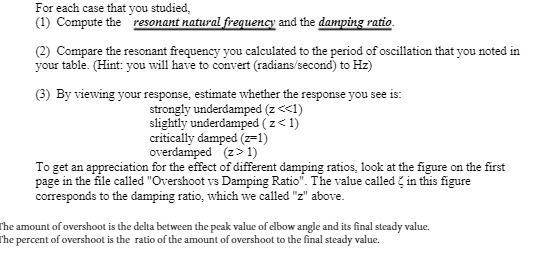Answered step by step
Verified Expert Solution
Question
1 Approved Answer
For each case that you studied, (1) Compute the resonant natural frequency and the damping ratio. (2) Compare the resonant frequency you calculated to

For each case that you studied, (1) Compute the resonant natural frequency and the damping ratio. (2) Compare the resonant frequency you calculated to the period of oscillation that you noted in your table. (Hint: you will have to convert (radians/second) to Hz) (3) By viewing your response, estimate whether the response you see is: strongly underdamped (z < 1) To get an appreciation for the effect of different damping ratios, look at the figure on the first page in the file called "Overshoot vs Damping Ratio". The value called in this figure corresponds to the damping ratio, which we called "z" above. The amount of overshoot is the delta between the peak value of elbow angle and its final steady value. The percent of overshoot is the ratio of the amount of overshoot to the final steady value.
Step by Step Solution
There are 3 Steps involved in it
Step: 1

Get Instant Access to Expert-Tailored Solutions
See step-by-step solutions with expert insights and AI powered tools for academic success
Step: 2

Step: 3

Ace Your Homework with AI
Get the answers you need in no time with our AI-driven, step-by-step assistance
Get Started


